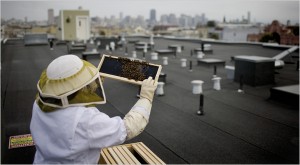 If you spy a dark-haired woman gliding down Mission Street, past the taquerias and bodegas, in a white, head-to-toe bee suit — picture a hazmat suit crossed with a fencing mask — chances are it’s Cameo Wood, en route to a beehive. Ms. Wood, the 32-year-old proprietor of the Mission District shop Her Majesty’s Secret Beekeeper, cares for 15 hives in “borrowed spaces” around San Francisco. These are hidden away in friends’ backyards, in a restaurant garden, and on the roofs of government buildings and apartment complexes.
If you spy a dark-haired woman gliding down Mission Street, past the taquerias and bodegas, in a white, head-to-toe bee suit — picture a hazmat suit crossed with a fencing mask — chances are it’s Cameo Wood, en route to a beehive. Ms. Wood, the 32-year-old proprietor of the Mission District shop Her Majesty’s Secret Beekeeper, cares for 15 hives in “borrowed spaces” around San Francisco. These are hidden away in friends’ backyards, in a restaurant garden, and on the roofs of government buildings and apartment complexes.
Urban beekeeping, or backyard beekeeping, is taking off in a major way in the Bay Area, as a growing brood of city dwellers is raising bees on rooftops, patios and small plots of land; harvesting the honey; and, in some cases, selling the yields in local shops and bakeries.
Ms. Wood started beekeeping in late 2008 and is a trailblazer in this growing movement, which is drawing a new crowd to a very old trade. At her nine-month-old shop, she sells beeswax candles, native honey, beekeeping supplies and a $200 starter kit that includes a two-tier cypress hive with a shiny copper roof. Since the shop opened last July, she has sold 130 kits and 450 pounds of bees, and hosted 21 beginner-level classes. In October 2009, she started a meet-up club, the San Francisco Urban Beekeeping Group, which attracts up to 60 attendees at each gathering.
Paul Koski, a retired schoolteacher and the current secretary of the San Francisco Beekeepers Association, a club that promotes responsible urban beekeeping, estimates that in 2000 there were about 50 beekeepers in the city. Today, according to Ms. Wood, there are “at least 400.”
Beekeeping is thriving in cities across the nation, from Washington to Chicago to New York (where, on March 16, it was re-legalized). But compared with most urban areas, San Francisco offers a particularly hospitable habitat. It has a temperate climate, abundant plant life and legions of residents obsessed with local and sustainable food.
Even better, it happens to be “one of the most permissive places in the country to keep bees,” said Karen Peteros, a part-time employment lawyer and a former president of the beekeepers association. “Not only is it legal, but it’s totally unregulated — which means that as long as your bees don’t present a public nuisance, you can keep them wherever you want.”
According to Ms. Peteros, the current beekeeping boom dates to 2007, when reports of colony collapse disorder, or C.C.D. (the still-unexplained phenomenon of honeybees disappearing en masse), hit the media, sparking interest right around the time the local food and urban greening movement was taking off.
“C.C.D. is the worst and best thing that’s happened to honeybees in the last 50 years,” Ms. Peteros said. People saw beekeeping as “a chance to be close to wild nature in the city and participate directly in the production of food,” as Ms. Peteros put it. She speaks from experience: the first year she kept a hive in her backyard, in 2006, her neighbors’ previously anemic fruit trees produced an epic harvest. “One plum tree was so bursting, my neighbor made plum jam for the first time,” she said. “Someone else’s apple tree was so weighed down, its branches started breaking.”
On the national level, beekeeping remains a commercial, male-dominated industry, entwined with agribusiness, with thousands of hives trucked in to pollinate sprawling fruit and nut orchards across the country. But in cities, among hobby-level and sideliner beekeepers, that demographic is swiftly changing. When Mr. Koski started attending the local bee association meetings in the early ’90s, there were just a dozen members, “mostly middle-aged and older, mostly men,” he said. “Now it’s a wider demographic, pretty much a cross-section of who lives in San Francisco” — including unprecedented numbers of women.
What everyone has in common, he observed, is an interest in food and sustainability, the environment and “making the city a greener, more favorable place for humans to live.” Last year, the association’s membership peaked at 207.
So, what’s the draw? As far as urban agriculture goes, beekeeping is accessible, inexpensive and low-maintenance, Ms. Wood said. And it “yields a rather large and delicious reward.” Harvests vary year to year and colony to colony, but a typical hive of 60,000 bees will produce, on average, between 40 and 60 pounds of honey.
Some of that honey ends up on the shelves at Mission Pie, a bakery and cafe in the Mission District that focuses on local, seasonal and sustainably grown produce. Krystin Rubin, a co-owner, said the shop sells between three and eight different varieties at any given time, each hailing from a different neighborhood, and each with its own particular flavor, depending on the bees’ favored foraging spots (most often groves of eucalyptus trees, blackberry bushes or clumps of wild anise).
San Francisco’s newfound bee love thrills Ms. Rubin, who attributes it to residents’ growing desire to connect with their food sources and counterbalance increasingly high-tech lives.
“There’s only so much FarmVille you can play on Facebook before you want to grow your own real radish,” she said. “We’ve got so much contact with the virtual world that we’re hungry to come back to earth.”
